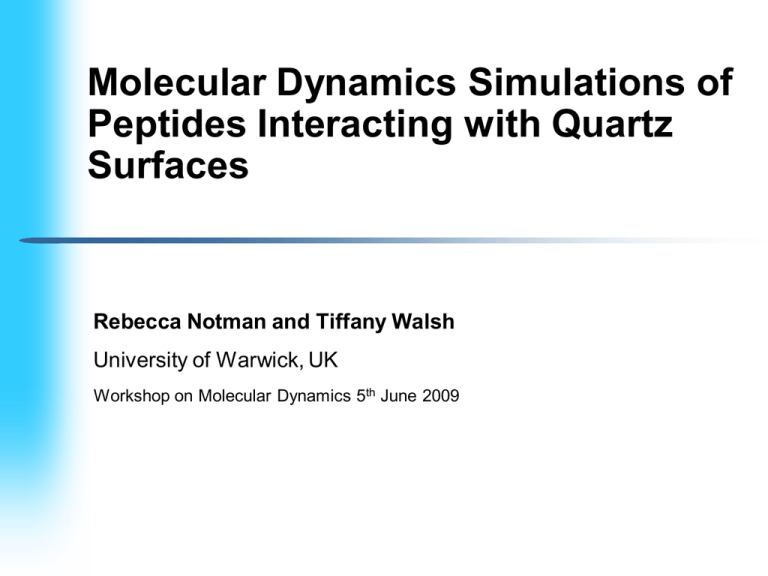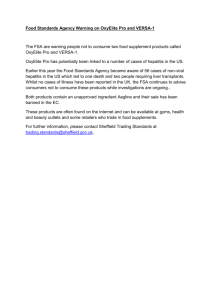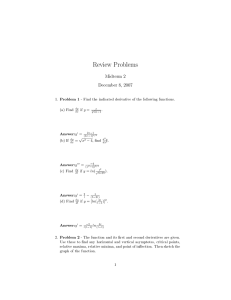Molecular Dynamics Simulations of Peptides Interacting with Quartz Surfaces
advertisement

Molecular Dynamics Simulations of Peptides Interacting with Quartz Surfaces Rebecca Notman and Tiffany Walsh University of Warwick, UK Workshop on Molecular Dynamics 5th June 2009 Peptide-inorganic interactions Proteins control the formation of natural hard materials. These proteins contain motifs that bind to the inorganic material. Magnetic nanoparticles formed by magnetotactic Magnetic nanoparticles bacterium formed by magnetotactic bacterium Understanding of peptide-inorganic recognition is necessary for Mother-of-pearl exploitation.Mother-of-pearl Diverse range of applications: – E.g. assembly of functional nanomaterials, biosensors. Mother-of-pearl Mother-of-pearl Magnetic nanoparticles Magnetic nanoparticles formed by magnetotactic formed by magnetotactic bacterium bacterium Mouse enamel: Sponge spicule of Rosella hydroxyapetite crystallites has layered silica with Mouse enamel: Sponge spicule of Rosella assembles into woven rod excellent optical and hydroxyapetite crystallites has layered silica with structure mechanical properites. assembles into woven rod excellent optical and structure mechanical properites. Sarikaya et al. Nat. Mater., 2003, 2, 577. Design of quartz binding peptides Phage Display Experimental Validation Bioinformatics TSS S S as high as possible TSS S W as low as possible Oren et al. Bioinformatics, 2007, 23, 2816. Quartz binding peptides Amino acid content: – Non-polar, neutral residues; – Pro, trp, leu occur frequently. S1: Pro Pro Pro Trp Leu Pro Tyr Met Pro Pro Trp Ser S2: Leu Pro Asp Trp Trp Pro Pro Pro Gln Leu Tyr His + Key questions: – What are the mechanisms of binding? – What are the roles of the residue content and order? – What molecular level features give rise to a high binding affinity for quartz? S3: Ser Pro Pro Arg Leu Leu Pro Trp Leu Arg Met Pro + + W1: Glu Val Arg Lys Glu Val Val Ala Val Ala Arg Asn + Trp Pro - Leu + - + Our approach Examine the nature of the thesurface surfaceand andthe the role roleofofwater water • Structure and dynamics of water at the interface. • Implications for binding. Peptide Surface (Quartz) Our approach Examine the nature of the thesurface surfaceand andthe the role roleofofwater water • Structure and dynamics of water at the interface. • Implications for binding. Characterise peptides ininsolution: solution Peptide Surface (Quartz) • Conformations of strong vs weak binders. • Relationship between sequence → structure → function. Our approach Examine the nature of the thesurface surfaceand andthe the role roleofofwater water • Structure and dynamics of water at the interface. • Implications for binding. Investigate the interactions of peptides withthe thesurface surface peptides with • Mechanisms of binding. • Key amino acid residues. • Structural motifs. Characterise peptides ininsolution: solution Peptide Surface (Quartz) • Conformations of strong vs weak binders. • Relationship between sequence → structure → function. Our approach Examine the nature of the thesurface surfaceand andthe the role roleofofwater water • Structure and dynamics of water at the interface. • Implications for binding. Investigate the interactions of peptides withthe thesurface surface peptides with • Mechanisms of binding. • Key amino acid residues. • Structural motifs. Characterise peptides ininsolution: solution Peptide Surface (Quartz) • Conformations of strong vs weak binders. • Relationship between sequence → structure → function. Molecular dynamics simulations • Provide a molecular-level insight. • CHARMM forcefield with silica parameters by Lopes et al. (bio and inorganic compatible), and TIP3P water (using Gromacs). Interactions of water with the hydroxylated (100) surface Water forms weakly structured layers on the surface of quartz. Water penetrates small pockets on the surface. Within the first water layer, water is also ordered laterally. – May affect the mobility and aggregation of bound molecules/peptides. z /nm Notman & Walsh Langmuir, 2009, 25, 1638. Hydrogen bonding and lateral diffusion on quartz (100) Water h-bonds to the quartz surface. There is a peak in water-water hbonds at the interface. H-bonds at the interface have a longer life time than h-bonds in the bulk (more stable). Leads to reduction in lateral diffusion of water on the surface. Free energy of small molecules as a function of distance to the (100) surface Water Methane, side chain of ala Methanol, side chain of ser Solution structures of the peptides S2 S1 Cluster 1 (21%) Cluster 1 (41%) Cluster 2 (21%) Cluster 2 (12 %) Cluster 3 (10%) • REMD Simulations. • Pro has significant influence on structure. • Cluster analysis used to identify key conformations: •Strong binders have fewer clusters. Pro Pro Pro Trp Leu Pro Tyr Met Pro Pro Trp Ser Cluster 3 (12%) Leu Pro Asp Trp Trp Pro Pro Pro Gln Leu Tyr His Solution structures of the peptides W1 S3 Cluster 1 (36%) Cluster 2 (15 %) Cluster 3 (7%) Cluster 1 (9%) Cluster 2 (8%) • REMD Simulations. • Pro has significant influence on structure. • Cluster analysis used to identify key conformations: •Strong binders have fewer clusters. Ser Pro Pro Arg Leu Leu Pro Trp Leu Arg Met Pro Cluster 3 (7%) Glu Val Arg Lys Glu Val Val Ala Val Ala Arg Asn Flexibility of the peptides Strong binders contain regions in the chain backbone that are locally, conformationally rigid. S1: two prolinerich regions connected by a semi-flexible spacer. S2: central proline-rich region flanked by semi-flexible chains at either end. Secondary structure Polyproline character S1 S2 S3 W1 Results are in agreement with CD spectra (Evans et al). Psi Random coil configuration Phi Hydrogen bonding Intra-peptide hydrogen bonds Peptide-water hydrogen bonds • Indicates that W1 has a greater intrinsic stability due to internal hydrogen bonds. • Strong binders achieve stability via interactions with the surface? Interaction energy Strong binders are less stable in solution than weak binders. S1 on quartz (100) surface S1 has many different bound configurations. This is the lowest energy configuration found so far. Pro 1, 2, 3, and 10 bind directly to the surface. Trp lies flat on the surface. S1 on quartz (100) surface S1 has many bound configurations. Common binding motifs. Peptide flat on surface Pro-2 Trp-11 Pro-6 Leu-5 Pro-2 Pro-3 Pro-6 Pro-9 Binding pockets? Pro-10 Ser-12 Trp-11 S2 on quartz (100) surface As with S1, pro binds directly to the surface. Leu and trp also bind. Trp binds either flat or perpendicular to the surface. W1 on quartz (100) surface W1 is bound via ala and val (nonpolar, neutral) and arg (basic). Fewer residues interact with the surface c.f. strong binders (lower surface coverage. Summary of interacting residues Adsorption Energies S1 S2 W1 Hydrogen bonding Strong binders form hydrogen bonds with the quartz surface. Weak binders h-bond to the surface at the expense of intramolecular h-bonds. Summary Adsorption of small hydrophobic moieties is favourable. Hydrogen bond formation may be a key driving force for interactions of biomolecules with quartz surfaces. The relative stability of a peptide in solution compared to the interface is likely to be a contributing factor. Proline is a key residue: – Plays a conformational role and binds directly to the surface. Our results support the idea that a peptide with a high binding affinity has many bound configurations. Current/future work: – Effects of mutating key residues on the binding free energy. Acknowledgements Tiff Walsh, University of Warwick. Mehmet Sarikaya, Emre Oren and coworkers, University of Washington. (Quartz binders) EPSRC for funding. CSC and NGS for computing facilities. Thank you.


